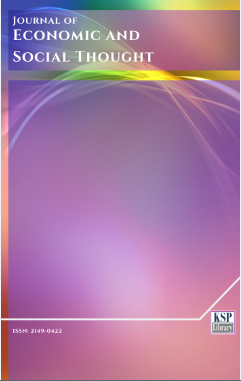University Institutional Research and Student Recruitment Performance: Utilizing Marketing Communication for Knowledge Heterogeneity
Abstract
Abstract. Institutional research constantly generate useful but heterogeneous knowledge for university administrations. Thus the effectiveness of institutional research dependes on the communication of those heterogeneous knowledge to major stakeholders (e.g., parents, students, teachers, etc.). A conceptual paper is developed in regards to the influences of institutional research, word-of-mouth (via internal students and faculties), quality signaling (to external prospect students and stakeholders as potential customers), and customer relationship management, on student recruitment performance as a special form of customer decision. Grounded on the marketing communication perspective, we propose that the student recruitment performance is largely affected by word-of-mouth, quality signaling, and customer relationship management as strategic marketing communications, which are facilitated by institutional research. Institutional research is interpreted as a strategic marketing tool that can help identify, communicate, and visualize the strengths of a university. The conceptual model contributes to the search for marketing mechanisms through which institutional research can generate impact to external stakeholders. Formal propositions and their implications for future, larger-scaled surveys were discussed.
Keywords: Institutional research, Word-of-mouth, Quality signaling, Customer relationship management, Student recruitment.
JEL. C40, H43, J68.Keywords
References
Allen, B.E. (1980). Information as an economic commodity. American Economic Review, 80(2), 268–273.
Anderson, E.W. (1998). Customer satisfaction and Word of Mouth. Journal of Service Research, 1(1)5-17. doi. 10.1177/109467059800100102
Astin, A.W. (1977). Four Critical Years. Effects of College on Beliefs, Attitudes, and Knowledge. ERIC.
Bartell, M. (2003). Internationalization of universities: A university culture-based framework. Higher Education, 45(1), 43-70. doi. 10.1023/A:1021225514599
Bedard, K. (2001). Human capital versus signaling models: University access and high school dropouts. Journal of Political Economy, 109(4), 749-775. doi. 10.1086/322089
Borden, V.M.H., & Banta, T.W. (1994). Using Performance Indicators to Guide Strategic Decision Making: New Directions for Institutional Research 82, Jossey-Bass.
Brown, S. & Price W.C. (1999). Customer Relationship Management: Linking People, Process, and Technology. Wiley, New York.
Campbell, A. (2003). Creating customer knowledge competence: Managing customer relationship management programs strategically. Industrial Marketing Management, 32(5), 375-383. doi. 10.1016/S0019-8501(03)00011-7
Eastman, J. (2003). Strategic Management of Universities? CSSHE Professional Files.
Eliashberg, J., & Robertson, T.S. (1988). New production preannouncing behavior: A market signaling study. Journal of Marketing Research, 25, 282-292.
Erdem, T., & Swait, J. (1998). Brand equity as a signaling phenomenon. Journal of Consumer Psychology, 7(2), 131-157. doi. 10.1207/s15327663jcp0702_02
Hartline, M.D., & Jones, K.C. (1996). Employee performance cues in a hotel service environment: Influence on perceived service quality, value, and word-of-mouth intentions. Journal of Business Research, 35(3), 207-215. doi. 10.1016/0148-2963(95)00126-3
Heil, O., & Robertson, T.S. (1991). Toward a theory of competitive market signaling: A research agenda. Strategic Management Journal, 12(6), 403-481. doi. 10.1002/smj.4250120602
Herbig, P., Milewicz, J., & Golden, J. (1994). A model of reputation building and destruction. Journal of Business Research, 31(1), 23-32. doi. 10.1016/0148-2963(94)90042-6
Herciu, M., & Ogan, C. (2015). An overview on European Union sustainable competitiveness. 16, 651-656. in Mihaescu, L., Marginean, S., Stoica, E.A., Grabara, J. (Eds.) Procedia Economics and Finance. doi. 10.1016/S2212-5671(14)00853-3
Herr, P.M., Kardes, F.R., & Kim, J. (1991). Effects of word-of-mouth and product attribute information on persuasion: an accessibility-diagnosticity perspective. Journal of Consumer Research, 17(4), 454-62. doi. 10.1086/208570
Jedamus, P., & Peterson, M. (1980). Improving Academic Management: A Handbook of Planning and Institutional Research. Jossey-Bass.
Jenkins, A., & Healey, M. (2005). Institutional strategies to link teaching and research. Higher Education Academy York.
Kotler, P. (1982). Marketing for Non-profit Organizations. Prentice-Hall.
Knight, W.E., Moore, M.E., & Coperthwaite, C.A. (1997). Institutional research: Knowledge, skills, and perceptions of effectiveness. Research in Higher Education, 38(4), 419-433. doi. 10.1002/ir.10403
Licata, J., & Frankwick, G.L. (1996). University marketing: A professional service organization perspective. Journal of Marketing for Higher Education, 7(2), 1-16. doi. 10.1300/J050v07n02_01
Mithas, S., Krishnan, M.S., & Fornell, C. (2005). Why do customer relationship management applications affect customer satisfaction. Journal of Marketing, 69(Oct.), 201-209. doi. 10.1509/jmkg.2005.69.4.201
Mok, K.-H. (2006). Education Reform and Education Policy in East Asia. Routledge: London.
Payne, A., & Frow, P. (2005). A strategic framework for customer relationship management. Journal of Marketing, 69(4), 167-176. doi. 10.1509/jmkg.2005.69.4.167
Richins, M.L. (1983). Negative Word-of-Mouth by dissatisfied consumers: A pilot study. Journal of Marketing, 47(Winter), 68-78. doi. 10.2307/3203428
Richins, M. (1984). Word of Mouth communication as negative information. Advances in Consumer Research, 11, 697-702.
Richins, M., & Root-Shaffer, T. (1988). The role of evolvement and opinion leadership in consumer Word-Of-Mouth: An implicit model made explicit. Advances in Consumer Research, 15, 32-36.
Saupe, J.L. (1990). The functions of Institutional Research. ERIC.
Serban, A.M. (2002). Knowledge management: The “Fifth Face” of institutional research. New Directions for Institutional Research, Wiley: New York. doi. 10.1002/ir.40
Spence, M. (1973). Job Market Signaling. Quarterly Journal of Economics, 87(3), 355-374. doi. 10.2307/1882010
Sundaram, D.S., Mitra, K., & Webster, C. (1998). Word-Of-Mouth Communications: a Motivational Analysis, Advances in Consumer Research, 25, eds. Joseph W. Alba & J. Wesley Hutchinson, Provo, UT: Association for Consumer Research, 527-531.
Trusov, M., Bucklin, R.E., & Pauwels, K. (2009). Effects of Word-of-Mouth Versus Traditional Marketing: Findings from an Internet Social Networking Site. Journal of Marketing, 73, 90-102. doi. 10.1509/jmkg.73.5.90
Verhoef, P.C. (2003). Understanding the effect of customer relationship management efforts on customer retention and customer share development. Journal of Marketing, 67(4), 30-45. doi. 10.1509/jmkg.67.4.30.18685
Winer, R.S. (2001). A framework for customer relationship management. California Management Review, 43(summer), 89-105. doi. 10.2307/41166102
Zhang, Z. Y. & Wei, R. G. (2009). An Empirical Study on the Conception and Behavior of University Stakeholders. Modern University Education.
DOI: http://dx.doi.org/10.1453/jest.v3i4.1069
Refbacks
- There are currently no refbacks.
Journal of Economic and Social Thought - J. Econ. Soc. Thoug. - JEST - www.kspjournals.org
ISSN: 2149-0422
Editor: [email protected] Secretarial: [email protected] Istanbul - Turkey.
Copyright © KSP Library




